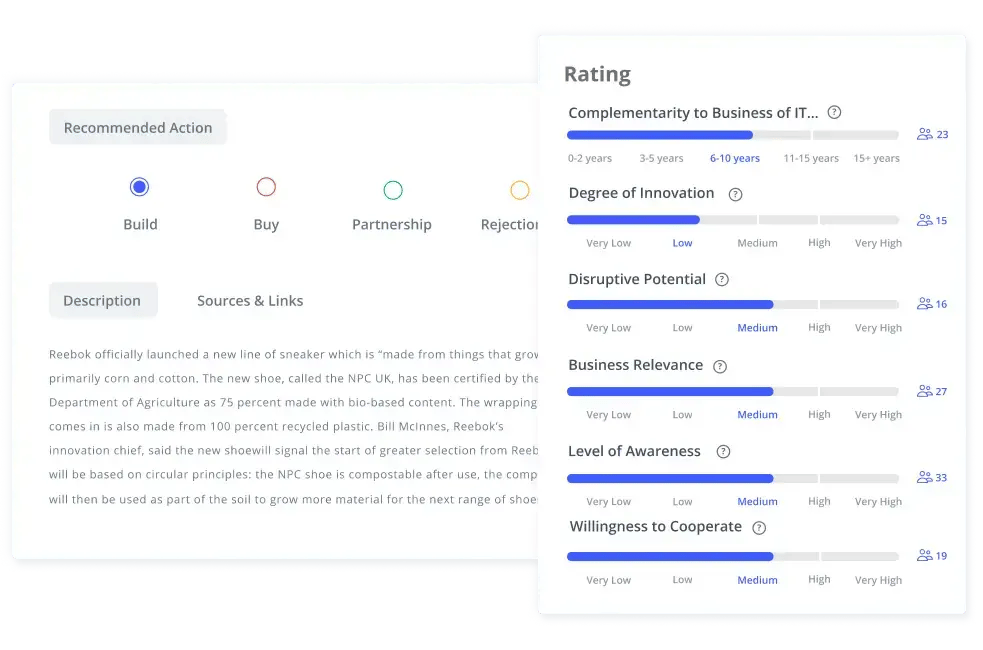A technology radar is like a lighthouse in the fog of uncertainty, guiding businesses toward opportunities and away from risks. Maintaining a tech radar is crucial to accurately represent the current state of the technology landscape, ensuring it is regularly updated to reflect the latest changes and inform strategic decision-making in an organization.
Visualizing emerging technologies and their impact within the business environment helps organizations navigate rapidly changing landscapes with clarity, ensuring they stay ahead of the curve and chart a successful course forward.
What is a technology radar
A technology radar is a visual tool that helps organizations identify, monitor, and prioritize emerging technologies. It organizes technologies into categories based on their relevance, urgency, and potential impact, often displayed in concentric circles or zones, allowing for the analysis and navigation of individual technologies.
This format makes it easy to see which technologies are closer to becoming actionable and which are still in the exploratory phase. It combines data, expert insights, and foresight to provide clarity in a rapidly changing world.

Regularly maintaining a technological radar is crucial to accurately reflect the evolving tech landscape, enabling informed decision-making regarding technology adoption and management.
For innovation professionals, a technology radar is essential for tracking shifts in software, hardware, and digital capabilities. Whether for R&D management or accelerating time-to-market, it ensures businesses stay ahead of the curve by highlighting future opportunities and challenges.
Why companies need a tech radar
Companies need a tech radar to stay competitive in an ever-changing market. It helps identify emerging opportunities and risks early, allowing businesses to adapt and innovate proactively.
Investing in new technologies at the right time can give businesses a competitive advantage, ensuring they stay ahead of the curve.
By organizing technologies based on reach, impact, confidence, and effort (cf. RICE prioritization framework), a technology radar allows teams to focus on what matters most. It supports better decision-making, ensures alignment with long-term goals, and reduces the risk of being blindsided by disruptive forces.
For innovation professionals, a tech radar fosters collaboration, streamlines technology scouting, and provides a clear framework for strategic planning. It’s an indispensable tool for building a future-ready organization that aligns with the goals of the entire business.
Benefits of having your own tech radar
Having your own technology radar offers numerous benefits for organizations and individuals alike.
By creating a personalized technology radar, you can stay ahead of your priorities and business-specific interests. This proactive approach allows you to make informed decisions about technology investments and adoption, ensuring that your strategies are aligned with both business and IT goals.
A well-crafted technology radar helps balance risk versus adoption, enabling you to prioritize technologies that offer the most significant potential impact. It enhances collaboration and communication among stakeholders, fostering a unified vision of the future. By identifying areas for innovation and growth, your organization can develop a competitive edge in the market.
Leveraging a technology radar allows you to establish technology leadership. Providing insights into new developments and emerging technologies will make you an attractive partner for other co-innovating companies. Plus, your customers will love your expression of expertise.
What is the optimal structure for a tech radar
A tech radar organizes information visually to make technologies easy to analyze and prioritize. Its structure includes several key components:
Segments: These divide the radar into categories, such as infrastructure, frameworks, tools, and programming languages. Segments help cluster and focus attention on specific areas of interest. Various techniques used in software development are also categorized within the radar, providing crucial insights for assessing and adopting technological tools effectively.
Distance to the Center: Technologies closer to the center are more urgent or impactful, while those farther away are less immediate but still worth monitoring.
Color: Colors represent the status or type of technology, such as emerging (green), maturing (yellow), or declining (red).
Size: The size of each technology indicates its potential impact or importance, with larger technologies requiring greater attention.
This structure ensures clarity, helping teams align insights with strategy.
What are emerging technologies
Emerging technologies are innovations that are in the early stages of development but have the potential to significantly impact industries, economies, and society. These technologies—such as artificial intelligence, quantum computing, blockchain, biotechnology, and renewable energy solutions—drive digital transformation, enhance efficiency, and create new business opportunities.
Considering emerging technologies is crucial for organizations to stay competitive and future-proof their strategies. They enable businesses to optimize processes, improve customer experiences, and unlock new revenue streams. Early adoption provides a competitive edge, while failure to monitor these advancements can lead to missed opportunities or industry disruptions.
Additionally, emerging technologies shape regulatory landscapes, consumer expectations, and market dynamics. Companies that integrate these innovations proactively can lead in their fields, influence industry standards, and navigate technological shifts with confidence. By leveraging technology radars and foresight tools, businesses can track, evaluate, and implement emerging trends effectively, ensuring long-term growth and resilience in an evolving landscape.
What are relevant technologies to track on a technology radar
The latest technologies to track depend on your industry and strategic goals but typically include advancements in segments like artificial intelligence, cloud computing, cybersecurity, automation, and emerging software architectures. Technologies that impact innovation, sustainability, digitalization, and customer engagement are especially important.
A good technology radar balances global megatrends, such as AI-driven automation or quantum computing, with emerging signals like federated learning or decentralized identity solutions. It’s also important to track cross-industry technologies that could create opportunities or disruptions.
Consider technologies that align with your organization’s focus, have high potential impact, or are gaining momentum in your sector, ensuring your radar remains actionable and future-focused.
How to rate technologies
Rating technologies involves evaluating their maturity, confidence, adoption readiness, and other criteria.
Here are some steps to follow:
Evaluate the technology’s business value and maturity: Assess how the technology aligns with your business goals and its level of maturity. Consider factors such as market adoption, proven use cases, and vendor support.
Assess the technology’s adoption readiness and confidence: Determine the readiness of the technology for adoption within your organization. Evaluate the confidence level based on past performance, reliability, and scalability.

Consider the technology’s potential impact on your organization: Analyze the potential impact of the technology on your operations, processes, and competitive position. Consider both short-term benefits and long-term strategic value.
Review and update your ratings regularly: Regularly review and update your ratings to reflect changes in the technology landscape and new insights. This ensures that your ratings remain relevant and actionable.
By rating technologies, you can prioritize your efforts and make informed decisions about technology adoption, ensuring that your organization stays ahead in the ever-evolving technology landscape.
How to create a technology radar that works
Step 1: Define the radar's scope and purpose
Start by clearly defining the focus of your technology radar. Identify the specific areas you want to explore, such as software development, cybersecurity, or digital transformation, and align these with your strategic goals. Determine the time horizon you’re considering—short-term, mid-term, or long-term—and the audience for your radar, whether internal teams or external stakeholders.
Having a tailored technology portfolio strategy is crucial to ensure that your technology investments are optimized and aligned with your strategic goals.
A clear scope ensures your radar remains actionable and relevant, helping you prioritize technologies that matter most to your business. It also prevents information overload, focusing attention on opportunities and challenges that directly impact your organization’s innovation and growth strategy, preparing you for the future today.
Step 2: Collect key technologies from different sources
Gather insights from diverse, credible sources to build a comprehensive radar that adapts to market changes. Use tools like industry reports, market research, and news analysis to identify global and regional technological trends. Leverage input from internal teams, expert panels, or foresight communities for unique perspectives.
Engineering teams play a crucial role in utilizing the Tech Radar tool, actively participating, sharing knowledge, and engaging in discussions about technology decisions to ensure the continuous evolution of the technology landscape.
Don’t overlook weak signals—early indicators of potential technological advancements—and explore sectors outside your own for cross-industry influences. Combining data-driven insights with expert knowledge ensures your radar reflects both emerging opportunities and well-established shifts, offering a holistic view of the evolving landscape.

Step 3: Define your evaluation criteria and categorize the technologies
Establish clear criteria to evaluate technologies, such as their potential impact, relevance to your organization, and time to maturity. Use these criteria for prioritizing technologies and categorizing them into actionable groups.
Arrange technologies on your radar based on urgency (distance from the center) and type (segments like software, hardware, or security). Use color and size to visually represent technology status and impact, making it easier to understand at a glance.
This structured approach ensures your radar is intuitive, helping decision-makers quickly grasp the most critical insights and align them with business strategy.
Step 4: Share your technology radar with the right audience
A tech radar is most effective when shared with those who can act on its insights. Tailor the presentation to your audience, whether it’s leadership, innovation teams, or external partners. Use clear visuals and concise explanations to make technologies understandable and actionable.
Encourage discussions around the radar to align stakeholders, prioritize initiatives, and explore opportunities. A collaborative approach ensures the radar doesn’t just inform but actively drives strategic decisions, fostering innovation and forward-thinking within your organization. If you are interested in personalized advice, seek tailored guidance on your technology portfolio strategy.
Step 5: Build a routine and regularly update your radar with emerging technologies
A technology radar isn’t static; it requires continuous monitoring to evolve with the environment. Establish a routine for monitoring and adding new technologies, revisiting existing ones, and removing outdated or irrelevant items.
Schedule regular updates—monthly, quarterly, or annually—depending on your industry’s pace of change. Engage your team in the process to incorporate fresh insights and ensure alignment with evolving priorities.
By maintaining an up-to-date radar, you’ll stay ahead of emerging opportunities and threats, keeping your organization agile and ready to adapt to the future. A dynamic radar is key to effective technology management.
The best real-world examples of working technology radars
Here are examples of tech radars used by different companies for technology planning, scouting, and monitoring.
Tech industry radar
Tech industry radar
The ITONICS tech trend report explores the key developments shaping the tech industry in the upcoming decade, the most pressing challenges to the current operating model of tech innovation, and the most promising measures to claim innovation leadership.

Access the interactive tech radar online.
Elia Group Tech Vision Radar
Elia Group Tech Vision Radar
Technology is transforming every aspect of human life. By employing the Tech Radar to monitor and evaluate emerging technologies, the Elia Group can identify the most impactful ones that demand our immediate attention today.

Access the interactive technology radar online.
The PCSI security radar
The PCSI security radar
The PCSI Security Radar provides an overview of the trends that the PCSI partners have indicated as the ones with the highest impact (either from a risk or opportunity perspective) on their cyber security posture.

Access the interactive PCSI security radar online.
Merz technology radar
Merz technology radar
The ITONICS Innovation Platform supports Merz in scouting new technologies and products for its pipeline.
The huge amounts of data generated in this process are easily discoverable for the colleagues on the tech radar and can be supplemented and evaluated together.

Read more about the Merz technology radar.
Cisco tech radar
Cisco tech radar
With the technology radar, Cisco found a solution to effectively and efficiently manage novel technologies to maintain and enhance its competitive position.

Read the complete success story here.
How to integrate a tech radar into your business operations
To integrate a tech radar, start by aligning it with your business strategy. Identify key areas where technologies can inform decision-making, such as product development, digital transformation, or R&D management.
Incorporate the radar into regular strategic planning and team discussions, ensuring leaders and teams understand its relevance. Use it to prioritize initiatives, allocate resources, and shape technology roadmaps.
Collaborate across departments to embed technology insights into operations, fostering a culture of forward-thinking. Update the radar regularly and link it to measurable goals, ensuring it remains actionable and supports your business in staying competitive and adaptable.
Create your own tech radar. Today.
The ITONICS Innovation OS provides you with the most interactive and widely used radar views. ITONICS is the only foresight software that allows you to connect your foresight activities with ideation and project portfolio management. Use it to:
Map your tech landscape in one view: Collect all relevant technology information to support investment decisions. Track TRLs, business potential, know-how, or your custom criteria. Modify the technology view to highlight what is important and share it with your team to spur action.
Communicate a shared vision of the future: Understand novel technologies and industry shifts to gain a competitive edge. Incorporate the radar into your presentations to get buy-in, add it to your intranet to engage employees, or embed it on a webpage to attract partners.
Make technology scouting less chaotic: Assign rights and roles to allow each tech scout to own a piece of the radar. Enable different departments and external experts to work collaboratively and shape the technology strategy of your company.











